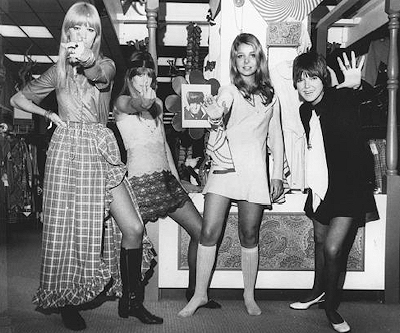

Beehive coiffures adorned by the likes of Princess Margaret, Jacqueline Kennedy and Brigette Bardot were imitated by women of all ages.

The hairdresser was of extreme importance in 1961. Skirts had risen to the middle of the kneecaps, but by the end of 1961 only the very young continued to wear them short. Many designers created “the look” by designing not just the dresses, but also the hats, shoes and even makeup of their mannequins. Oval shaped shoulders and tapered hemlines were being replaced by straighter, wider shoulders, accompanied by a gentle inward curve at the midriff and a flare at the hem. The fashionable woman liked to go out in the evening dresses in an expensive but simply cut dress known affectionately as “little nothing.” She never left home without an elegantly styled bouffant hairdo. Jackie Kennedy (1961)In 1961, fashion was all about the costume look. Evenings turbans of tulle swirled loosely around the head not only gained high fashion acceptance, but were sold in every hat shop. In contrast, neon bright pink was also a very popular color for those looking to make a statement.įurs and hats maintained their popularity, as did fur and seal coats. Colors like like grape, plum, wine red, garnet and olive green. They especially covered the spectrum between purple, red and green. Coat and suit woolens were usually loosely woven and sometimes as porous as lace.ĭeep, darker colors were the rage in 1960.

Wools were in style, but had to lightweight. Abstract and expressionist art were big influences on printed silk designs. Plaids of all sizes and colors were heavily favored. Such rarities as natural vicuna for suits, brocades at $40 per yard, 24 karat gold lace, Renaissance-patterned metal brocades and cut velvets set against a gold background were all samples from fashion collections in 1960. The two- or three-piece suit, mix-and-match, was very popular.ĭesigners embraced opulence, even in the most pragmatic clothing. Some dresses had draped cowl backs to intensify the elongated look. Collarless coats, suits and dresses created a long-necked effect. Sleeveless daytime shirts placed more emphasis on the arms. While worn with low-heeled shoes it placed more attention on the leg. The long dress of sequins or crystal beads had replaced the bouffant dress. Bead and sequin embroidered evening clothes sparkled the night away. There were also hints of the twenties and thirties with bloused, bias-cut clothes, long straight overblouse and sashed tunics, short skirts, closely fitting hats and exaggerated makeup (especially red lips) and short hair.Ĭulottes, divided skirts and trim trouser skirts were introduced for travel, street wear and evenings at home.
60s fashion art full#
Long-waisted dresses, often with an overblouse, replaced the fitted waistline and full skirt.Ĭontemporary architecture and sculpture were the most prevalent inspirations for fashion designers in 1960. The typical daytime look consisted of a bulbous hat over a high bouffant coiffure, silhouettes with deep armholes an wide sleeves, and a rounded jacket that tapered in at the hem.For evening, the slender look was in. While there were several important tweaks to the status quo, no revolutionary new ground had been broken. Givenchy suit (1960)Although the 1960s are best known as a decade of experimentation, it didn’t start out that way in the fashion world.


 0 kommentar(er)
0 kommentar(er)
